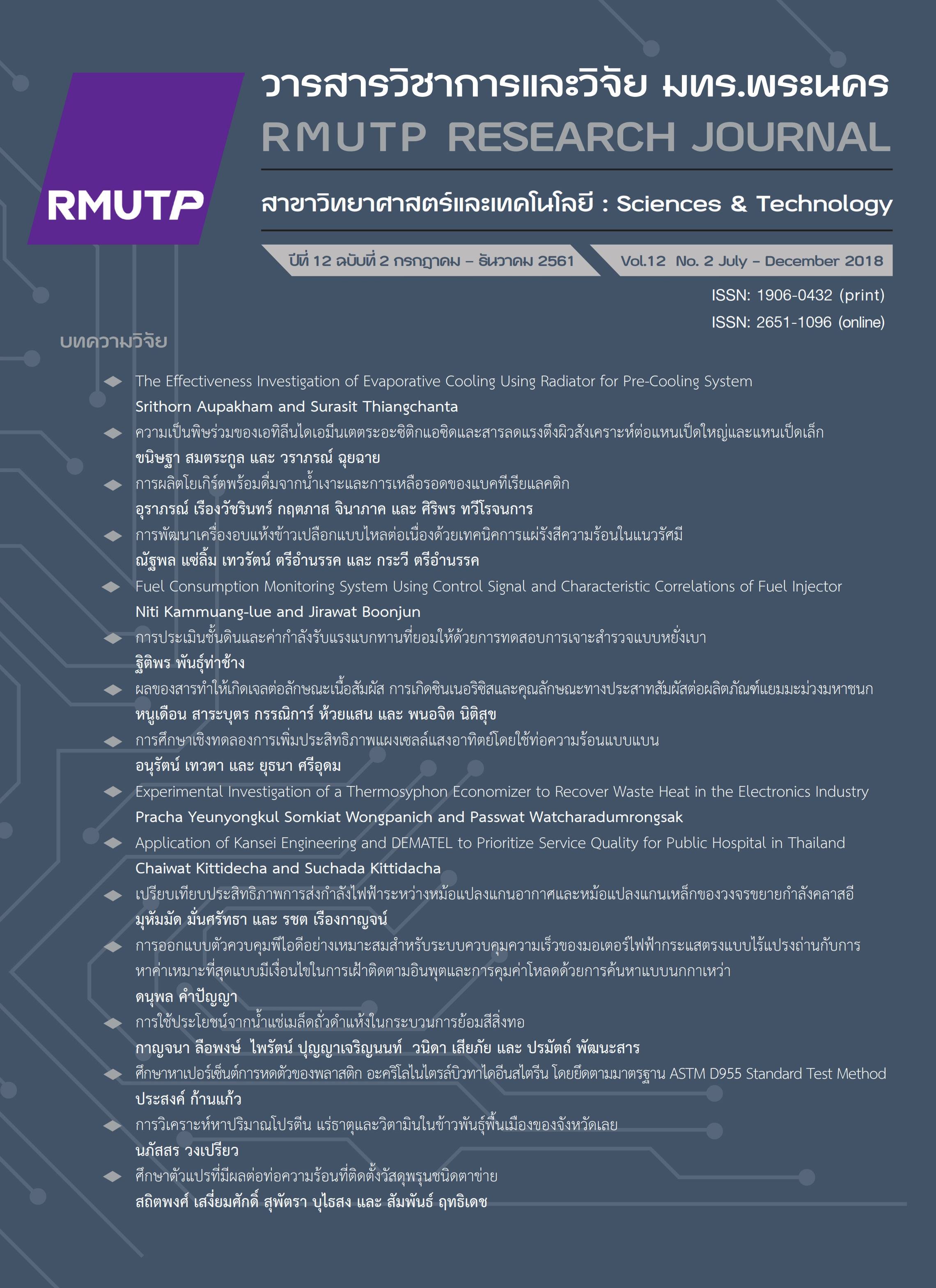Study of parameters have effected to the heat pipe with mesh wick
Main Article Content
Abstract
This research aims to study the parameters have affected the heat pipe which was studied the heat transfer characteristics of heat pipe installed with mesh wick. The the heat pipe are made of copper pipe of internal diameter 10 and 12 mm, 30 cm length which mesh wick installed inside the pipe. The Working fluids contained the heat pipe were distilled water, ethanol and refrigerants-11 (R11). There was 50% filling ratio of the evaporator section volume and the evaporator section temperature is set at 50, 70 and 90 oC. In the condenser section has cooling at a water flow rate of 0.5 L/min and compared to the heat pipe without mesh wick. Based on the research results, it was found that the heat pipe installed mesh wick has internal diameter 12 mm, R11 as working fluid and the evaporator section temperature was 90 oC has highest heat transfer rate was 73.3 W and the heat pipe efficiency was 58.2%. Due to the wicks will help transfer the working fluid in the condensation come back to evaporator section that allows the condensed liquid to spread around the walls of the heat pipe. As a result of the working fluid condensed to the evaporator section was well and affected to higher heat transfer rate, in addition to R11 as working fluid have low boiling points and latent heat of vaporization is higher than ethanol and distilled water respectively, which effect to highest heat transfer rate.
Article Details
References
[2] L.L. Vasiliev, “Micro and miniature heat pipes-electronic component coolers,” Applied Thermal Engineering, vol. 28, pp. 266–273, 2008.
[3] J. Hirunlabh, P. Chantawong and J. Khedari, “A simple-low cost solar water heater for Thailand,” KMUTT Research and Development Journal, vol. 23, pp. 109-120, 2000.
[4] สถิตพงศ์ เสงี่ยมศักดิ์, สุพัตรา บุไธสง และวิริยะ แดงทน, “เครื่องทำน้ำอุ่นพลังงานแสงอาทิตย์จากท่อความร้อนที่ติดตั้งวัสดุพรุนภายใน,” การประชุมวิชาการเครือข่ายวิศวกรรมเครื่องกลแห่งประเทศไทย ครั้งที่ 31, นครนายก, ประเทศไทย, 4-7 กรกฎาคม 2560.
[5] P. Naphon, “On the performance of air conditioner with heat pipe for cooling air in the condenser,” Energy Conversion and Management, vol. 51, pp. 2362-2366, 2010.
[6] H. Akachi, F. Polasek and P. Stulc, “Pulsating heat pipes,” in Proceedings of the 5th International Heat Pipe Symposium, Melbourne, Australia, 1996, pp. 208–217.
[7] สุรเชรษฐ์ สีชำนาญ, ธีรพัฒน์ ชมพูคำ และสัมพันธ์ ฤทธิเดช, “การเพิ่มประสิทธิภาพแผงเซลล์แสงอาทิตย์โดยใช้ท่อความร้อนที่ติดตั้งวัสดุพรุนแบบตาข่ายทองแดง,” วารสารวิชาการ วิศวกรรมศาสตร์ ม.อบ. ปีที่ 9, ฉบับที่ 1, pp. 11-22, 2559.
[8] สัมพันธ์ ฤทธิเดช, “เทคโนโลยีท่อความร้อน,” มหาสารคาม: สำนักพิมพ์มหาวิทยาลัยมหาสารคาม, 2553.
[9] L. Godson Asirvatham, R. Nimmagadda and S. Wongwises, “Heat transfer performance of screen mesh wick heat pipes using silver-water nanofluid,” International Journal of Heat and Mass Transfer, vol. 60, pp. 201-209, 2013.
[10] A. Brusly Solomon, K. Ramachandran, L. Godson Asirvatham and B.C. Pillai, “Numerical analysis of a screen mesh wick heat pipe with Cu/water nanofluid,” International Journal of Heat and Mass Transfer, vol. 75, pp. 523–533. 2014.

